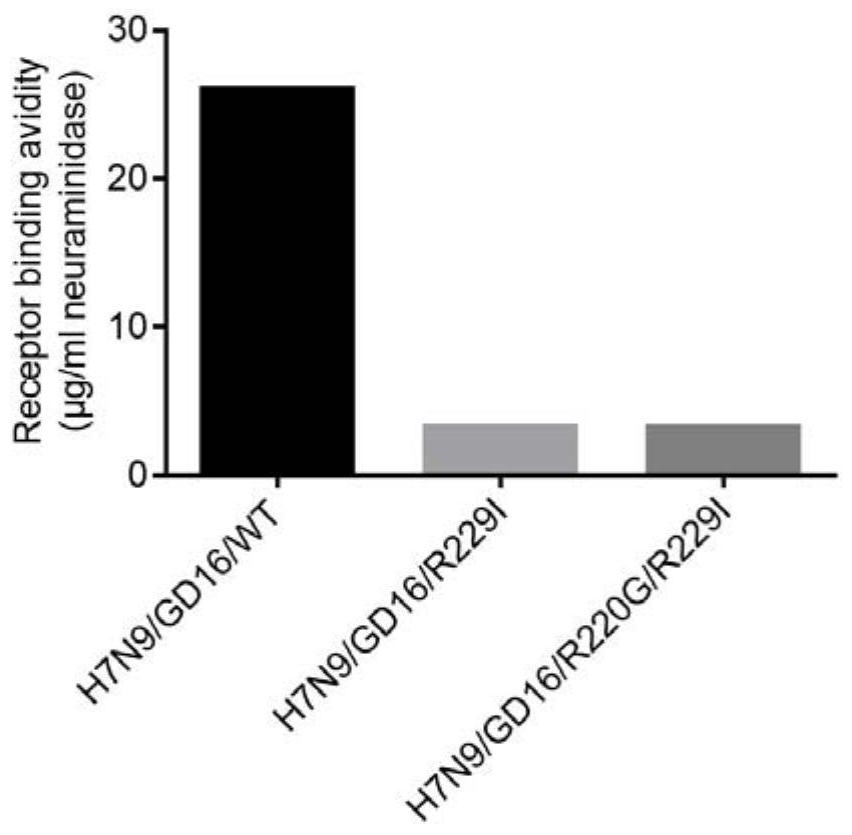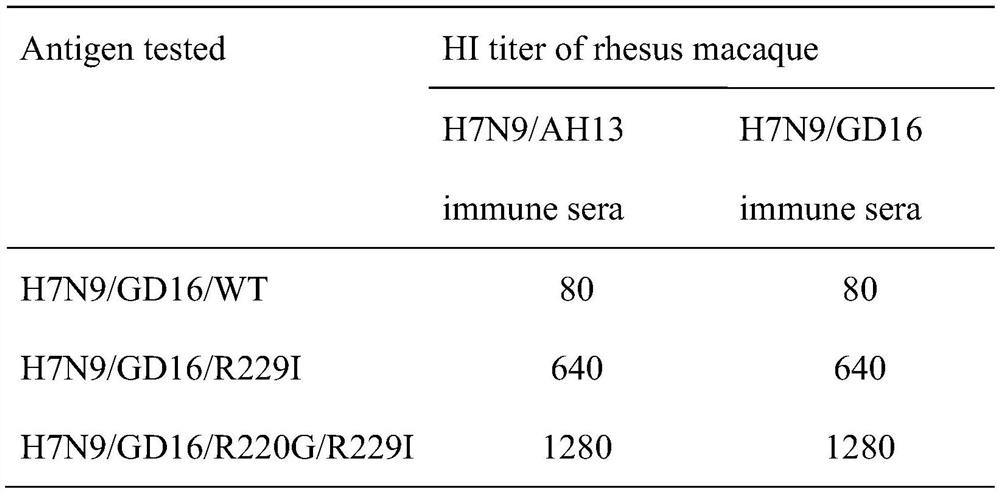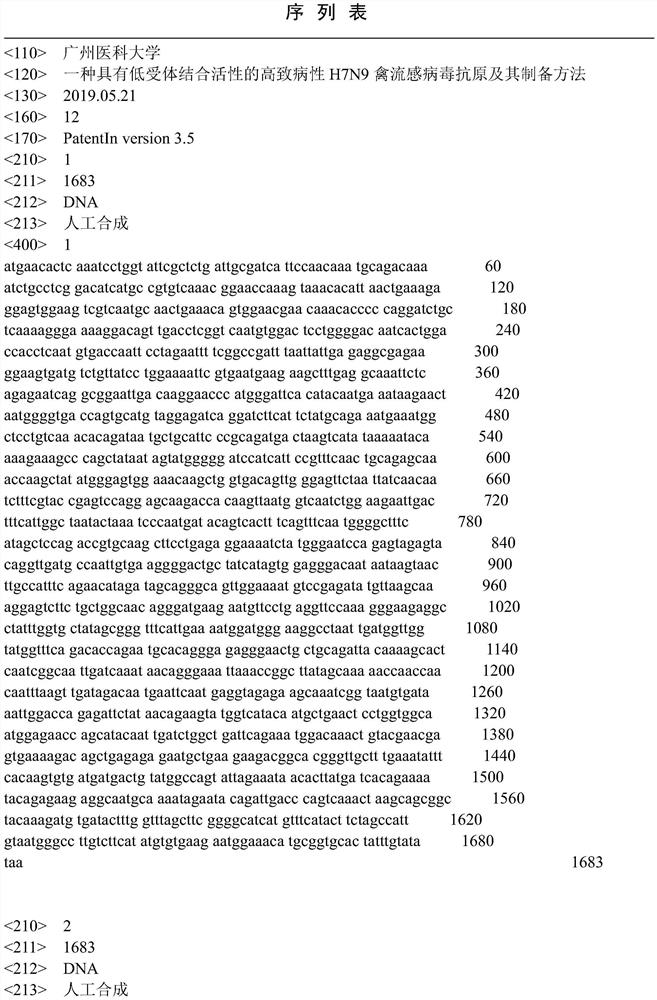A highly pathogenic h7n9 avian influenza virus antigen with low receptor binding activity and preparation method thereof
An avian influenza virus, highly pathogenic technology, applied in the field of virus genetic engineering, can solve the problems of receptor affinity results, low receptor binding activity, etc., to improve accuracy, improve biological safety, and reduce HA protein receptors The effect of binding affinity
- Summary
- Abstract
- Description
- Claims
- Application Information
AI Technical Summary
Problems solved by technology
Method used
Image
Examples
Embodiment 1
[0036] Methods for reducing HPAI H7N9 influenza virus receptor binding affinity
[0037] The first step is to synthesize the HA gene: First, according to the HA gene sequence of the HPAI H7N9 influenza vaccine strain A / Guangdong / 17SF003 / 2016 (H7N9) recommended by WHO, synthesize the HA gene with multiple basic amino acids deleted at the cleavage site, and the cleavage site The HA gene with multiple basic amino acids deleted (named H7 / GD16 / WT) was completed by GenScript. Existing studies have shown that the cleavage site with multiple basic amino acids is a sign of highly pathogenic avian influenza virus, and deletion of multiple basic amino acids can reduce its pathogenicity, so that the recombinant virus can be used in the biosafety secondary experiment. The procedure is performed in the chamber without affecting the immunogenicity of the HA protein. For safety reasons, the cleavage site in the HA gene of the HPAI H7N9 influenza vaccine strain with the characteristics of hig...
Embodiment 2
[0052] The difference between Example 2 and Example 1 lies in the site-directed mutation of the HA gene and the process of viral recombination: in Example 2, the arginine (R) at position 229 of the HA protein was first mutated to isoleucine (I), and then Then the arginine (R) at position 220 of the HA protein was mutated to glycine (G);
[0053] First, the arginine (R) at position 229 of the receptor binding region (encoded according to the H3 sub-HA sequence, corresponding to the 238 position of the H7 coding sequence) was mutated to isoleucine (I) to prepare the recombinant plasmid pM- H7 / GD16 / R229I; then site-directed mutagenesis was performed on the recombinant plasmid pM-H7 / GD16 / R229I, and the arginine (R) at the 220 site of the HA protein was mutated to glycine (G). The site-directed mutagenesis primers:
[0054] R220G-F: CGAGTCCAGGAGCAGGACCACAAGTTAATG, corresponding to SEQ ID NO. 6 in the sequence listing;
[0055] R220G-R: CATTAACTTGTGGGTCCTGCTCCTGGACTCG, correspondin...
Embodiment 3
[0061] The difference between Example 3 and Example 1 is that the NA fragment in Example 3 is selected from the N9NA gene with non-oseltamivir resistance mutation. The NA gene containing the oseltamivir resistance mutation has the effect of oseltamivir resistance, and the HPAI H7N9 influenza virus prepared using this mutated NA gene has the risk of drug resistance gene flooding, by using non-oseltamivir Drug-resistant mutated NA genes can avoid widespread influenza virus dissemination with oseltamivir-resistant mutated NA genes. In Example 3, the synthesis of the HA gene of H7 / GD16 / WT, the construction of the pM-H7 / GD16 / WT recombinant plasmid, the site-directed mutation of the HA gene, and the virus rescue process were the same as those in the above-mentioned Example 1.
[0062] The first step is to select the NA gene of LPAI H7N9 vaccine strain A / Anhui / 1 / 2013 (H7N9) (GISAIDID:EPI439509, called N9 / AH13), N9 / AH13 is completed by GenScript, N9 / AH13 The sequence is shown in SEQ ...
PUM
 Login to View More
Login to View More Abstract
Description
Claims
Application Information
 Login to View More
Login to View More - R&D
- Intellectual Property
- Life Sciences
- Materials
- Tech Scout
- Unparalleled Data Quality
- Higher Quality Content
- 60% Fewer Hallucinations
Browse by: Latest US Patents, China's latest patents, Technical Efficacy Thesaurus, Application Domain, Technology Topic, Popular Technical Reports.
© 2025 PatSnap. All rights reserved.Legal|Privacy policy|Modern Slavery Act Transparency Statement|Sitemap|About US| Contact US: help@patsnap.com



